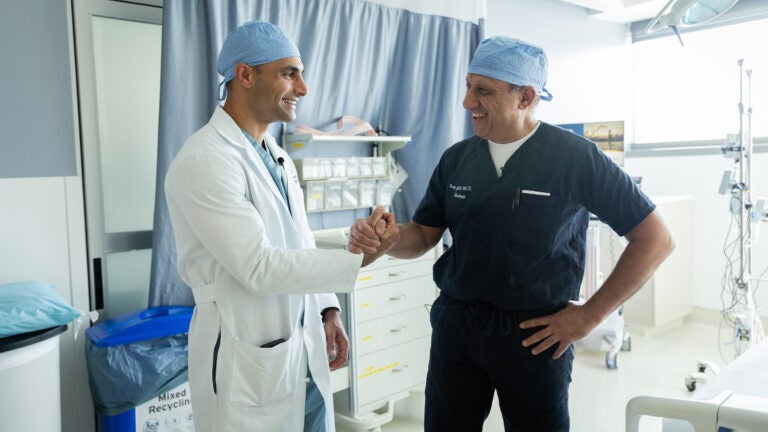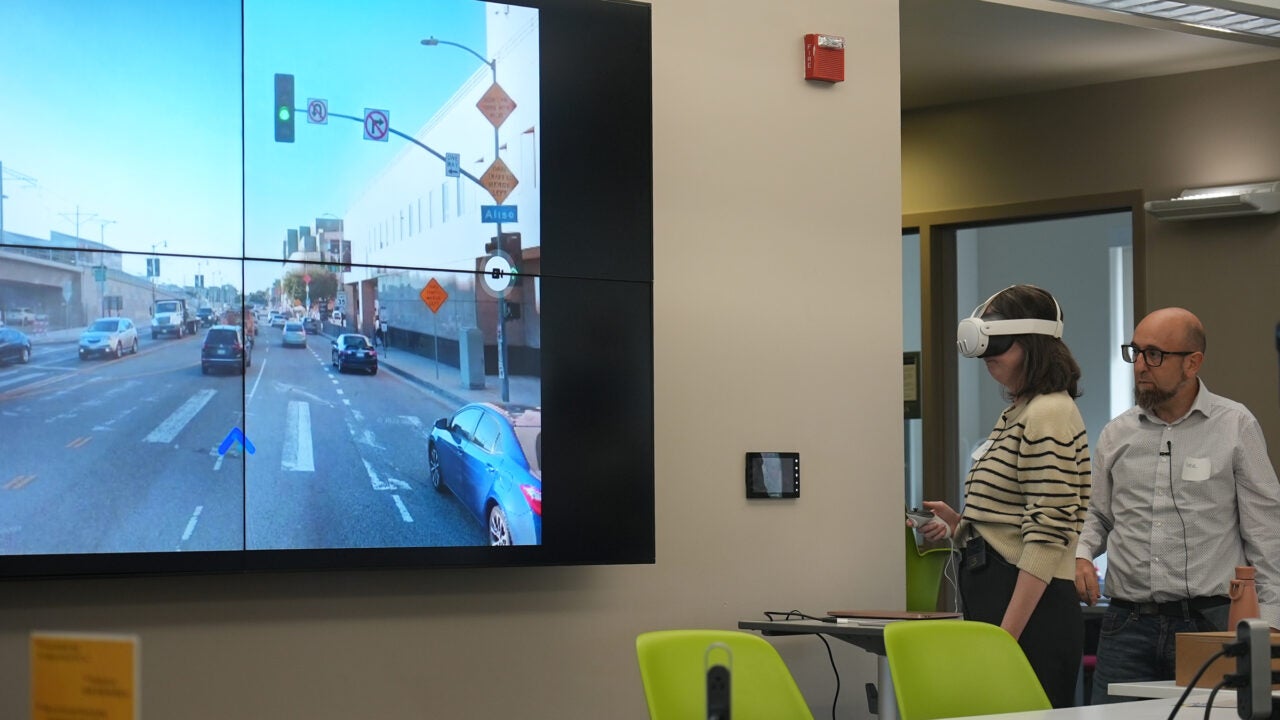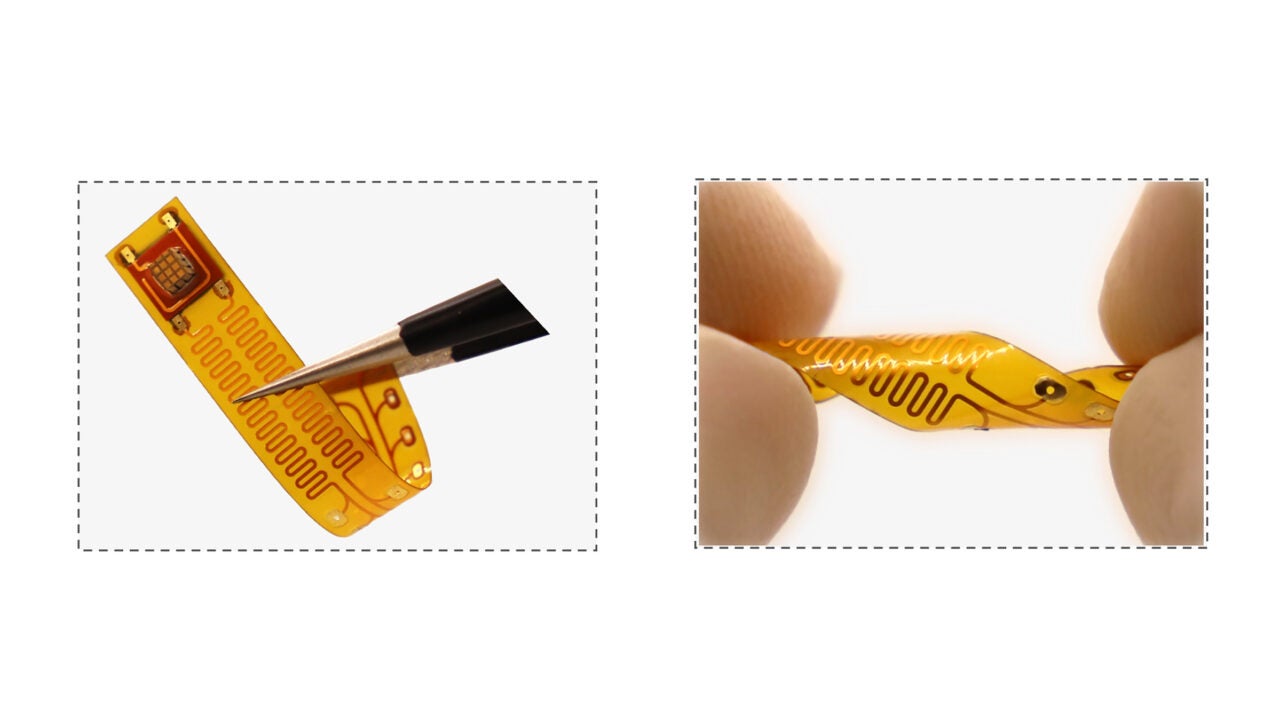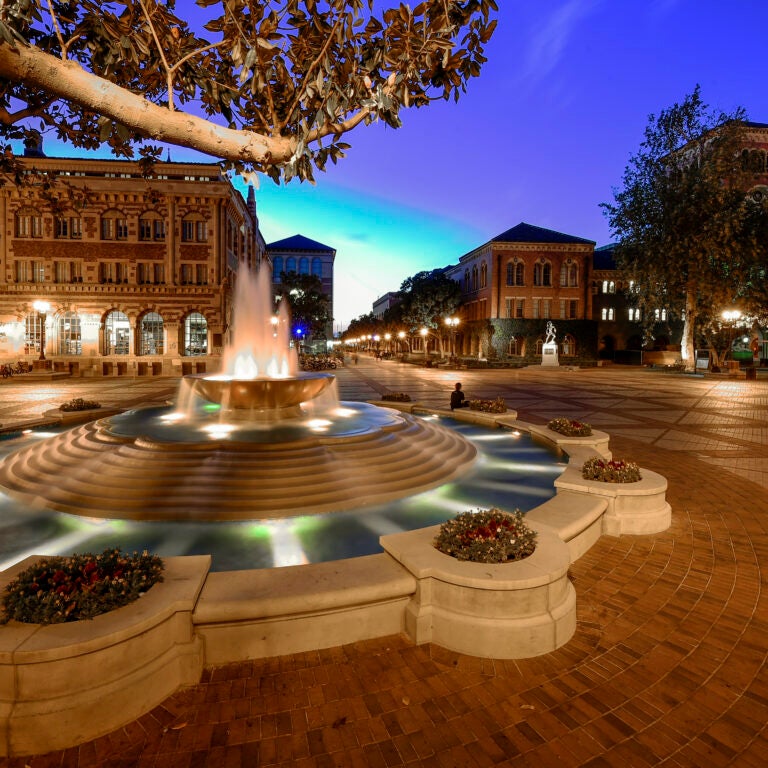
USC’s Inderbir Gill (right) and UCLA’s Nima Nassiri worked on a collaborative surgery that was the result of more than four years of research and preparation.(Photo/Couresy of: Nick Carranza, UCLA Health)
USC and UCLA: 10 ways these football rivals are partners off the field
Trojan and Bruin faculty and students often work together to tackle societal challenges and spark discovery in medicine, technology and more. (They even play games together!)
Since 1929, USC and UCLA have been fierce rivals in football. The famed Bruin football coach Red Sanders once said that the USC-UCLA rivalry isn’t a matter of life or death: “It’s more important than that.”
But when it comes to actual matters of life and death — such as finding groundbreaking cures for disease or recovering from natural disasters — the two athletic adversaries put aside competition to accelerate discovery and confront challenges.
“USC and UCLA have a long history of collaboration in researching and helping to solve the most complex problems facing our city and our world,” says Ishwar K. Puri, USC’s senior vice president of research and innovation. “Trojans and Bruins may be foes on the football field, but in operating rooms, science labs and academic centers across the two campuses, we share knowledge that reflects the innovative spirit and interdisciplinary excellence of these two leading Los Angeles institutions.”
“Los Angeles is a city built on collaboration, where universities, scientists, researchers, doctors, engineers and artists, Bruins and Trojans intersect every day,” says Roger Wakimoto, UCLA’s vice chancellor for research and creative activities. “While there is a fierce rivalry on the field (Go Bruins!), UCLA embraces that spirit to advance research, innovation and public service that saves lives and improves lives across Los Angeles and the world.”
The following USC-UCLA collaborations offer a window into the depth and breadth of cooperative research and other joint activities unfolding on both campuses — and the magnitude of what’s possible when crosstown rivals join forces.
1. Performing the world’s first bladder transplant
In May, surgeons from Keck Medicine of USC and UCLA Health performed the world’s first bladder transplant in a human at Ronald Reagan UCLA Medical Center. The groundbreaking surgery — a combined kidney and bladder transplant — was co-led by Inderbir Gill, founding executive director of USC Urology, and Nima Nassiri, urologic transplant surgeon and director of the UCLA Vascularized Composite Bladder Allograft Transplant Program.
Gill and Nassiri, who was Gill’s former resident in urology at the Keck School of Medicine of USC, worked together for over four years prior to the surgery to develop new surgical techniques and perform preclinical procedures at Keck Medical Center of USC and OneLegacy, Southern California’s organ procurement organization. Their innovations promise to revolutionize the way urologists treat a select subset of patients with debilitating bladder conditions and significantly enhance their quality of life.
“The patient is now over six months out [of surgery] and continues to do very well,” says Gill, chairman and Distinguished Professor of Urology, the Shirley and Donald Skinner Chair in Urologic Cancer Surgery. “This shows the durability of the operation to date. Dr. Nassiri and I are still collaborating. We are planning to perform the next bladder transplant soon.”
2. Predicting psychological distress
Depression has been called a “silent killer” because its symptoms can be masked or hidden from loved ones, sometimes with tragic consequences. Aiming to better identify people at risk of suicide, an interdisciplinary team of researchers from USC and UCLA is working to develop cognitive science tools to detect depression and suicidal ideation using neuro- and biobehavioral signals. The goal is to develop automated screening tools that help clinicians apply precision medicine to address everyone’s unique mental health situation.
Called PRECOG, the project is led by Shri Narayanan, Niki and Max Nikias Chair in Engineering and University Professor of Electrical and Computer Engineering and Computer Science at USC Viterbi. Supported by the Defense Advanced Research Projects Agency (DARPA), the project, initiated in 2023, is inspired by the need to support service members, veterans and the broader public.
“It has been a tremendous fortune to work with UCLA colleagues all driven by the common goal of understanding the human condition across the lifespan and creating veritable means for supporting it,” says Narayanan, who has joint appointments in linguistics and psychology at the USC Dornsife College of Letters, Arts and Sciences and pediatrics and otolaryngology at the Keck School of Medicine of USC. “Critically, my colleagues at UCLA, leaders in the domains of mental health and well-being, have not only enriched our interdisciplinary engineering research through keen and deep scientific and clinical insights but have also been wonderful mentors to scores of students on our collective teams.”
3. Rebuilding after the wildfires
Following the devastating January wildfires in Pacific Palisades and Altadena, the USC Lusk Center for Real Estate partnered with the UCLA Ziman Center for Real Estate and the nonprofit Urban Land Institute Los Angeles to create a comprehensive plan to help guide rebuilding efforts and strengthen the region’s long-term resilience. The partners convened approximately 100 leading experts — including faculty from USC and UCLA — specializing in land use, real estate, infrastructure and economic development to develop a roadmap for recovery.
In March, they published the report Project Recovery: Rebuilding Los Angeles after the January 2025 Wildfires. Continually updated to reflect new developments, the report addresses everything from labor and supply chain issues to the troubled property insurance market and offers strategic recommendations for helping affected areas to rebuild faster, more affordably and with greater climate adaptations.
“Faculty at USC and UCLA are citizens of Los Angeles, and when tragedies happen, citizens come together,” says Richard Green, a team lead on Project Recovery, professor at the USC Price School of Public Policy and the USC Marshall School of Business, and director of the USC Lusk Center for Real Estate and and chair of the Wilbur H. Smith III Department of Real Estate Development at USC Price. “Both universities have great strengths that complement each other.”
4. Evaluating health in an aging population
How do life circumstances and environmental exposures affect our biology and our health as we age? That’s one of the central questions that researchers at the USC/UCLA Center on Biodemography and Population Health seek to answer. Founded in 1999 and sponsored by the National Institute on Aging, the center is a partnership between the USC Leonard Davis School of Gerontology and UCLA Health Geriatric Medicine.
One example of the impactful population health research is a recent study led by the center’s co-director Jennifer Ailshire, professor of gerontology and sociology at USC Leonard Davis, which found that greater exposure to extreme heat may accelerate biological aging in older adults.
“USC and UCLA have collaborated for more than 25 years and have changed the field of demography of aging,” says the center’s co-director Eileen Crimmins, University Professor and AARP Chair in Gerontology at USC Leonard Davis. “We will continue to be stronger together as we have been in the past.”
5. Cooling the city with shade
In Los Angeles, where the number of extreme heat days is projected to increase 31% by 2050, strategies to cool the hottest neighborhoods are urgently needed. Shade — whether from a tree, canopy, awning or bus shelter — is one of the most effective, low-cost ways to reduce heat risk.
ShadeLA, led by USC Dornsife Public Exchange in collaboration with UCLA Luskin Center for Innovation, unites civic, academic and community partners to expand urban tree canopy and shade infrastructure in key public and community spaces. Launched in July with participation by the city of Los Angeles, County of Los Angeles Chief Sustainability Office, L.A. Metro and the Los Angeles Organizing Committee for the 2028 Olympic and Paralympic Games (LA28), the campaign aims to build lasting heat resilience for Angelenos as major sporting events like the 2028 Olympic and Paralympic Games approach.
“ShadeLA is stronger because USC and UCLA are working side by side,” says Kate Weber, executive director of USC Dornsife Public Exchange. “UCLA’s research depth, especially on urban heat and shade mapping, complements USC’s strengths in applied problem-solving and urban design innovation. A regional effort of this ambition is only possible because two major universities are joining forces — aligning research, data and design to deliver real benefits for the communities we call home.”
6. Immersing in digital humanities

The Immersive Technologies and Cultural Heritage (ITCH) Symposium features presentations of immersive digital humanities projects created by scholars from USC and UCLA. (Photo/Courtesy of Ahmason Lab)
Earlier this month, the third annual Immersive Technologies and Cultural Heritage (ITCH) Symposium took place in Leavey Library. The symposium, co-sponsored by USC Dornsife and the Ahmanson Lab at the USC Libraries, features presentations of immersive digital humanities projects created by scholars in archaeology, urban history, ecology and other disciplines. Attendees also discuss the promise and challenges of using technologies such as virtual reality (VR), augmented reality (AR) and extended reality (XR) to reimagine cultural heritage research, teaching and engagement.
In previous years, the event has gathered scholars from around the globe. But this year, presenters came exclusively from USC and UCLA, and the UCLA XR Initiative served as a co-host. “The goal for this year was to strengthen the ‘crosstown’ pathways for conversation and collaboration,” says Amy Braden, director of programs for the USC-Huntington Early Modern Studies Institute, the USC Mellon Humanities in a Digital World, and USC Mellon Humanities and the University of the Future grants. She is one of a team of co-organizers that includes Ahmanson Lab Director Curtis Fletcher, Ahmanson Lab Project Coordinator Mats Borges and Sean Fraga, assistant professor of environmental studies and history at USC Dornsife. They work in partnership with UCLA colleagues Francesca Albrezzi and Joy Guey.
“The UCLA XR Initiative shares our goals of fostering AR/VR/XR projects that bring together collaborative groups of students, faculty and staff for creative solutions, new forms of storytelling and research engagement,” Braden says. “AR/XR/VR technologies advance rapidly and projects require collaboration, so working with partners at UCLA is essential to keeping pace and maximizing the potential of our resources.”
7. Relieving pain without drugs
The Zhou Lab’s new implantable device for chronic pain management is designed to bend and twist with the spine’s movement and has a wireless power supply, eliminating the need for batteries. (Photo/Credit Zhou Lab)Chronic pain has a severe impact on quality of life, often leading to reliance on addictive painkillers with severe side effects. Surgically implanted electrical stimulators offer an alternative by stimulating the spinal cord to block pain signals from reaching the brain. But these devices can be bulky and are often hardwired to batteries that must be replaced frequently, requiring invasive surgeries.
Researchers in the Zhou Lab at the USC Viterbi School of Engineering, teamed up with the Jun Chen Group at the UCLA Samueli School of Engineering to develop a groundbreaking wireless implant for personalized chronic pain relief that sidesteps these problems. The new device is designed to bend and twist with the spine’s movement and has a wireless power supply, eliminating the need for batteries. It also harnesses machine learning algorithms to customize treatment for each patient.
Led by Qifa Zhou — Zohrab A. Kaprielian Fellow in Engineering and professor of biomedical engineering at USC Viterbi, and professor of ophthalmology at Keck School of Medicine — the research group’s study published in Nature Electronics in May demonstrated that the implant provided effective pain relief in rodents.
8. Finding a path forward on homelessness
Los Angeles County has the nation’s largest unsheltered homeless population: approximately 47,000 people, according to official estimates. The instability of their housing can make it difficult to track individuals over time and assess their needs and the risks they face.
An ongoing research partnership between the USC Suzanne Dworak-Peck School of Social Work and the UCLA Fielding School of Public Health uses mobile phone surveys to monitor the health, housing and service needs of people experiencing unsheltered homelessness in Los Angeles County. Data collected by the project, known as PATHS (Periodic Assessment of Trajectories of Housing, Homelessness, and Health Study), is used to inform policy decisions and interventions that improve outcomes for this vulnerable population.
Led by co-principal investigators Benjamin Henwood, Albert G. and Frances Lomas Feldman Professor of Social Policy and Health at the USC Suzanne Dworak-Peck School of Social Work, and Randall Kuhn at UCLA Fielding, the team was recently awarded $3.4 million by the NIH to expand their study. With the new funding, the researchers will use PATHS to examine the impact of encampment resolution programs that connect people living in encampments to interim housing such as hotel rooms and offer pathways to permanent housing.
9. Extending years spent in good health
As scientists seek to prevent disease and prolong the human lifespan, a pressing challenge has emerged: helping people live not just longer lives, but healthier and more independent ones. In October, the National Institute on Aging awarded a $6.5 million, five-year grant to USC, UCLA and Cedars-Sinai to create a new Los Angeles research hub where extending “healthspan,” the portion of life spent in good health, is a core part of the mission.
The Los Angeles Claude D. Pepper Older Americans Independence Center will focus on “translational geroscience,” research that turns discoveries about the biology of aging into practical treatments that prevent disease and increase healthspan. Pinchas Cohen, dean of the USC Leonard Davis School of Gerontology and Distinguished Professor of Gerontology, Medicine and Biological Sciences, serves as a co-director of the center alongside fellow co-director Jonathan Wanagat, a geriatrician at UCLA Health. The center is led by principal investigator Sara Espinoza, professor of medicine, director of the Center for Translational Geroscience, and co-director of the Diabetes and Aging Center at Cedars-Sinai.
Combining the expertise and resources of these three institutional partners offers a significant advantage in improving the quality of life of older adults. Their collaboration will also be part of a national consortium of 15 research institutions across the country conducting trials on aging.
10. Playing games for glory

The gridiron isn’t the only place where Trojans and Bruins face off each fall. They also compete on the gaming screen. Established in 2020, E-Conquest is an annual video game tournament hosted by USC Games, the university’s game design program, in collaboration with UCLA ESports.
“It’s Trojan pride on the line in electronic format,” says Jim Huntley, associate professor in the USC School of Cinematic Arts’ Interactive Media & Games Division and head of marketing for USC Games.
Traditionally, E-Conquest is held during Conquest Week, the Thursday before the USC-UCLA football game, though this year’s event was held early on Friday, Nov. 21, due to the Thanksgiving holiday. Around 50 players from each school converged on the USC University Park Campus to compete across eight esports titles in front of hundreds of in-person and livestream spectators on the USC Games and USCesports Twitch channels. The competition titles included PUBG Mobile, League of Legends, Marvel Rivals, Overwatch, Rocket League, Super Smash Bros. Ultimate, Tetris and Valorant.
The USC team led the UCLA team in three of the eight titles and tied them in Valorant. Though it wasn’t the sweep USC hoped for, Saturday’s football game offers the chance for Trojan conquest on the field.



